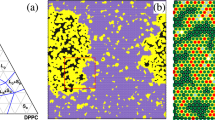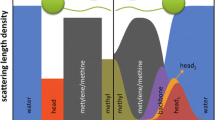Abstract
Most lipids do not pass, on heating, directly from a crystalline structure to an isotropic structure. They are often characterized by a number of intermediate phases, ranging from the plastic crystal, where the center of gravity of the molecule may rotate about one or more axes while the three-dimensional order of the crystal remains, to nematic liquid crystals, which have birefrigent properties of crystals and yet are characterized by completely random ordering of the molecular centers. The smectic and cholesteric liquid crystalline structures are most commonly encountered in lipids. The structural characteristics of these systems are discussed.
Of particular interest in living systems are liquid crystals, which are formed by cholesteric esters and many protein materials, and the two-dimensional crystals (smectic structure), which are formed by fatty acid derivatives. The mechanisms of energy transfer and the mechanical alignment in these liquid crystalline systems are unique and require different considerations from those found adaptable to liquids or solids. The properties of liquid crystals which might best be associated with living systems will be discussed, including surface properties and diffusivity.
Similar content being viewed by others
References
Lehmann, O., Z. Physik. Chem.4, 462 (1889).
Lehmann, O., Scientific American, Supplement No. 2039, p 80 (1915).
Chapman, D., and P. Byrne, Nature202, 987 (1964).
Luzzati, V., and F. Husson, J. Cell Biol.12, 207 (1962).
Cope, F. W., Molecular Crystals2, 45 (1966).
Dintenfass, L., Acta Haemat.32, 299 (1964).
Stewart, G. T., Molecular Crystals1, 563 (1966).
Fergason, J. L. Ibid.1, 293 (1966).
Brown, G. H., and W. G. Shaw, Chem. Rev.57, 1049 (1957).
Gray, G. W., “Molecular Structure and the Properties of Liquid Crystals,” Academic Press, New York, 1962.
Robinson, C., Molecular Crystals1, 467 (1966).
Unpublished data in laboratory of the authors.
Frank, F. C., Disc. Faraday Soc.25, 19 (1958).
Sneddon, Ian N., “Elements of Partial Differential Equations,” McGraw-Hill Book Company Inc., New York, 1957.
Perutz, M. F., Nature161, 204 (1948).
Deaver, G. L., C. F. Whitten and J. H. L. Watson, Federation Proc.22, 601 (1963).
Hansen, T. A., Nature190, 504 (1961).
Fergason, J. L., N. N. Goldberg and C. H. Jones, “Detection of Gases by Use of Liquid Crystals,” Technical Report No. RADC-TR-64-569, U.S. Department of Commerce, August 1965.
Author information
Authors and Affiliations
About this article
Cite this article
Fergason, J.L., Brown, G.H. Liquid crystals and living systems. J Am Oil Chem Soc 45, 120–127 (1968). https://doi.org/10.1007/BF02915335
Issue Date:
DOI: https://doi.org/10.1007/BF02915335




